By: Rebecca Mikkelsen

It’s easy to take water for granted, isn’t it? We open a tap and there it is: clean and plentiful. But there are causes for concern. Our region, like others, is facing a crumbling infrastructure with an unmet need of more than $600 billion dollars, according to SOURCE. Conservation attitudes and techniques in some other countries far outpace ours. A sustainable supply of fresh water for California is fraught with economic, environmental and political challenges.
Community-managed water departments serve as stewards of this most crucial resource. Some of the largest entities in our region share their perspectives on their work regarding water supplies, rates and conservation.
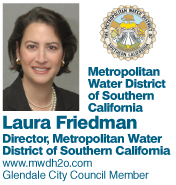
Today, the Metropolitan Water District of Southern California (Metropolitan) has the largest water reserves in its history...more than 3 million acre feet of water stored in reservoirs and underground basins throughout the region and in California’s Central Valley and Lake Mead along the Colorado River. (An acre-foot of water is nearly 326,000 gallons, about the amount used by two typical families a year.) Metropolitan typically provides about 2 million acre feet a year to Southern California.
The Southland’s reliable water supply, despite the relatively dry winter, is due to prudent water management decisions and investments by Metropolitan, including major investments over the past 20 years to significantly improve supply reliability for the 19 million people in our six-county service area.
Two of those investments were the construction of Diamond Valley Lake (DVL) in Riverside County, Southern California’s largest reservoir, and the Inland Feeder, 44 miles of pipes and tunnels connecting the State Water Project (SWP) to DVL. The SWP receives water from Northern California and distributes it to 25 million residents from the Bay Area to Southern California and to thousands of acres of farmland in the Central Valley.
Metropolitan’s system allows the region to take advantage of wet years, like 2011, by maximizing storage of supplies when water is available for use in dry years, such as the one we’re in now. (The final 2012 Sierra Nevada snowpack survey shows water content is only 40 percent of normal.)
While the water picture is promising in the short-term, looking longer range, it is critical that state and federal agencies move forward in developing a comprehensive water system/ecosystem improvement strategy in the Sacramento-San Joaquin Delta to improve water reliability for the entire state.
That strategy is embodied in the Bay Delta Conservation Plan (www.baydeltaconservationplan.com), which Metropolitan strongly supports. A draft BDCP proposal is scheduled for release this summer.
Reliable imported water supplies are essential to support Southern California’s $1 trillion economy as is conservation...continued efficient use of water...in our everyday lives. Being water wise (www.bewaterwise.com) must be a permanent way of life throughout our region and across the state.
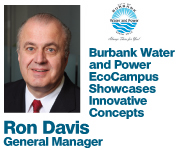
For nearly 100 years, the Burbank Water and Power (BWP) has been providing Burbank with safe, reliable and affordable energy and water services. Our goal is to make sure that we continue to provide exceptional service to the Burbank community over the next 100 years. The path to doing so includes keeping a keen eye on innovative technologies and maintaining a focus on sustainability.
The modernization of the BWP campus, an undertaking that began over a decade ago, is one example of our commitment to environmental protection. Our industrial site has gone from an aging, and quite frankly, tired-looking campus to a beautiful destination point in the region. This work in progress, which we now refer to as the BWP EcoCampus, boasts many environmental attributes. Here are three attributes that make the EcoCampus special:
Transforming Lake Avenue into a Green Street. The south side of the BWP campus is bordered by three city blocks of Lake Street. We asked ourselves how to expand the functionality of our public right of ways. Streets should certainly be pedestrian friendly, but why not use them as a stormwater filtration and capture system at the same time? We transformed this entire stretch to demonstrate five different stormwater capturing technologies. Our goal is to make the 23-acre EcoCampus a zero water run-off site. It’s a lofty goal, but one that we are confident we will achieve.
Re-purposing obsolete infrastructure. We sought the opportunity to re-frame, re-program, and re-purpose our industrial site wherever possible. For example, instead of tearing down a massive steel structure that used to house an array of transformers, we re-purposed this into an impressive garden trellis.
Green Roofs. We built three rooftop gardens on our main building, incorporating non-thirsty native plants. These gardens capture rain water for irrigation, use recycled water for any additional watering needed, and reflect back heat from the sun, significantly reducing the costs to cool the building. So, not only are they beautiful to look at, they conserve energy as well!
This is truly just the tip of the iceberg of what makes the BWP EcoCampus one of the most comprehensive sustainable projects in southern California. We’re really proud of the site – which was recently named a Sustainability Showcase Award Winner by the California Sustainability Alliance. Please visit BWP online at BurbankWaterAndPower.com to learn more about the EcoCampus!
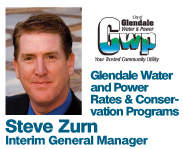
Water Supply: What plans does your organization have in place to secure water supplies? Where does the bulk of your water come from? What share from the Metropolitan Water District? Do you foresee a time that water will be rationed?
Glendale Water and Power (GWP) is always trying to maximize use of local resources and rely less on water purchased from the Metropolitan Water District (MWD). To that end, GWP has re-commissioned an old abandoned well, and is drilling one additional well. In addition, GWP is always looking for opportunities to serve more recycled water for irrigation. Overall GWP purchases 65% of its water from MWD. This is down from 70% a few years ago.
Water rationing is always on the horizon because of the uncertain hydrology and the state's pumping restrictions and regulations. A mandatory water conservation ordinance is in place in case we need to implement restrictions again, as was done in 2010 and 2011. We are always prepared to address the issues of water shortages and ramp up the conservation message according to circumstances.
Rates: What changes does your organization foresee with your rates in the next 12 months to 36 months? What are the anticipated Municipal Water District rate increases and the impacts on your rates?
The Glendale City Council recently modified the water rate structure and approved increases for the next three years. MWD rates are expected to increase approximately five percent per year. Out of necessity, these increases will be passed on to customers. Overall, GWP rates compare favorably to other utilities in the region and we are always looking for ways to keep costs as low as possible for customers.
Conservation: What programs and incentives do you offer to help reduce use and costs among commercial, industrial, institutional, non-profit and governmental customers? Do these programs differ among the user categories? How about small and medium-sized companies that open a new account at an existing building or space?
GWP offers programs and incentives for all customer classes, including our Commercial, Industrial and Institutional customers. Our commercial programs are divided into large-medium business customer and medium-small business customer categories.
GWP offers our medium-small business customers a direct install program of water and electric saving features. These customers may choose up to $2,000 worth of upgrades which are installed by our specialists. Our large-medium business customers are eligible to receive rebates for energy saving projects through our Business Energy Solutions program.
Both customer groups are eligible to participate in our Solar Solutions program which provides rebates to customers who install a photovoltaic system at their property. GWP also offers rebates on water-saving devices from MWD through their Save Water, Save a Buck program.
Non-Profit and Governmental customers are eligible for same programs as small, medium and large business customers. For details and to learn more about GWP’s business programs, customers can visit our website at http://www.glendalewaterandpower.com/businesses/
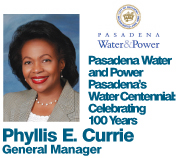
Pasadena Water and Power (PWP) is making a splash in 2012, celebrating the monumental effort that has gone into quenching our city’s thirst for the past 100 years.
Ever since 1912, when the City of Pasadena had purchased and consolidated several privately held water companies that had sprung up during the burgeoning city’s early history, Pasadena’s municipal water service has grown into a complex, 23-square-mile system of wells, reservoirs and pipelines, all managed and maintained by dedicated corps of professionals. Today, PWP is proud to offer superior, reliable service and a range of water-efficiency incentives to nearly 176,000 consumers in Pasadena and neighboring communities.
PWP is committed to responsible management of its resources and finances. In 2010 it adopted a 25-year water supply plan, incorporating sustainability and self-reliance as guiding principles. Between 2010 and 2012, PWP also adjusted rates to align with the true cost of maintaining a modern water service and to encourage greater conservation. Our state-of-the-art Monk Hill Water Treatment Plant came online in 2011 revitalizing a local water source and reducing the city’s reliance on water imports from the Metropolitan Water District, now down from 66 to 58 percent. All three of these recent initiatives were pursued through an intensive public engagement process, a hallmark of a community-owned utility. For more information visit: www.ci.pasadena.ca.us/waterandpower.
Centennial festivities are planned throughout the summer, and we extend a warm invitation to the business community and our regional agency partners to partake. First up, the Pasadena Museum of History will have a special water exhibit as part of its annual birthday party for Pasadena, set this year for Saturday, June 23 from noon to 4 p.m. Photos, records and artifacts from the Water Department’s early years will be on display. More activities will be posted at www.PWPweb.com/Centennial
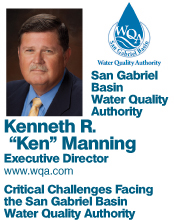
The California Legislature established the San Gabriel Basin Water Quality Authority (WQA) in 1993 to develop, finance and implement treatment programs for the San Gabriel Basin. This groundwater basin is the primary source of drinking water for the residents who live in this 225 square mile area from the San Gabriel Mountains to the city of Whittier. The water was contaminated during the Cold War when defense industries within the valley disposed of rocket fuel, industrial solvents and other dangerous chemicals by pouring them onto the ground. These chemicals ultimately seeped into the groundwater just a few hundred feet below the surface.
To date, the WQA has been very successful in implementing the cleanup of this very valuable asset. The WQA and its partners have treated over 1 million acre-feet (one acre-foot of water is 326,000 gallons – enough water for two families of five for a year) of water and have pulled from that water more than 120,000 pounds of contaminants. But despite spending $623 million during the past 18 years, the WQA estimates another $700 million will be needed to build and operate the treatment program. Where that money will come from in today’s government budget-cutting climate, in which federal and state funding appear unavailable, worries WQA officials and others concerned about local water quality.
For the most part, water agencies and the responsible parties who have helped fund the cleanup so far agree that the WQA has done a good job coordinating efforts and developing funding sources for cleanup; without asking ratepayers to foot the bill. But times are different now and the WQA has to work even harder to develop new approaches to funding. Recently, the State of California has joined the effort with a Prop 84 grant for over $10 million dollars and representatives in Washington DC are sponsoring legislation to allow greater flexibility in how the federal dollars can be expended.
Ultimately, the WQA and its board of directors are determined to make sure that the valley’s ratepayers are not overburdened in this effort to restore the San Gabriel Basin.

|